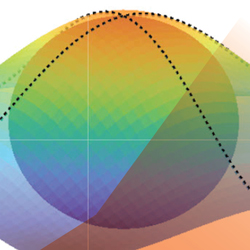Quantum Geometry in Condensed Matter: Fundamentals and Applications
 Quantum geometry in condensed matter physics provides a powerful lens for exploring emergent electronic and topological properties in materials. Geometric quantities such as Berry curvature and quantum metric, which respectively characterize the phase and distance evolution of electronic wavefunctions in parameter space, play a crucial role in revealing and engineering a wide range of intriguing phenomena and functionalities. Examples include quantum anomalous Hall systems (including higher-order and nonlinear variants), unconventional superconductivity, and Chern insulators in two-dimensional moiré and topological materials. Recent advances have also highlighted the role of quantum geometry in strongly correlated systems, fractional topological phases, and nonlinear optical and transport responses, as well as its tunability via strain engineering in emerging material platforms. Understanding the impact of quantum geometry on the electronic properties of these systems, and its interplay with topology, electron interactions, and symmetry, is not only a fundamental endeavor but also has practical implications for next-generation quantum technologies. This special collection aims to encourage cross-disciplinary dialogue and map new directions in one of the most vibrant frontiers of modern condensed matter physics.
Quantum geometry in condensed matter physics provides a powerful lens for exploring emergent electronic and topological properties in materials. Geometric quantities such as Berry curvature and quantum metric, which respectively characterize the phase and distance evolution of electronic wavefunctions in parameter space, play a crucial role in revealing and engineering a wide range of intriguing phenomena and functionalities. Examples include quantum anomalous Hall systems (including higher-order and nonlinear variants), unconventional superconductivity, and Chern insulators in two-dimensional moiré and topological materials. Recent advances have also highlighted the role of quantum geometry in strongly correlated systems, fractional topological phases, and nonlinear optical and transport responses, as well as its tunability via strain engineering in emerging material platforms. Understanding the impact of quantum geometry on the electronic properties of these systems, and its interplay with topology, electron interactions, and symmetry, is not only a fundamental endeavor but also has practical implications for next-generation quantum technologies. This special collection aims to encourage cross-disciplinary dialogue and map new directions in one of the most vibrant frontiers of modern condensed matter physics.
Topics covered include, but are not limited to:
- Novel theoretical frameworks for quantum geometry
- Geometry–topology interplay in higher-order topological phases, geometric constraints on topological invariants, quantum phase transitions, etc.
- Quantum geometry and electron interactions, including effects on strongly correlated systems, Mott transitions, magnetic ordering, Landau levels, and quantum Hall phenomena
- Moiré and topological materials with quantum geometry underlying correlated states, fractional Chern insulators, flat-band phenomena, and higher-order topological effects
- Unconventional superconductors influenced by quantum geometry, including geometry-driven pairing, superfluid density, and Berry curvature effects on vortex dynamics and the mixed state
- Emerging material platforms featuring quantum geometry, including Dirac and Weyl semimetals, topological crystalline insulators, and strain-engineered van der Waals heterostructures
- Quantum anomalous Hall effect and its variants (geometry, Chern numbers, higher-order quantum anomalous Hall phenomena, and device applications)
- Nonlinear optical and transport phenomena driven or related to quantum geometry, including Berry curvature dipoles, quantum metric dipoles, shift current photovoltaics, and curvature-induced scattering
- Quantum technologies leveraging geometric phases, topological quantum computing, and geometry-based sensing
- Experimental probes of Berry curvature and quantum metric (e.g., optical, transport, scanning probes, real-space mapping, and cQED techniques)
Guest Editors
Arpit Arora, UCLA, US
Tse-Ming Chen, NCKU, Taiwan
Joel I-Jan Wang, MIT, US
